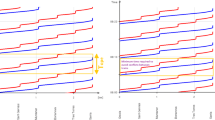Abstract
Accurate estimated capacity of the railway section can provide reliable information to railway operators and engineers in decision-making, particularly, in an emergency situation. However, in an emergency, the optimization of capacity of a railway section is usually involved to study, for example, the characteristics of dynamic, fuzziness, randomness, and non-aftereffect properties. This paper presents a proposed capacity calculation method based on the modified fuzzy Markov chain (MFMC). In this method, the capacity of a railway section in an emergency can be expressed by a fuzzy random variable, which remains the randomness of capacity changing according to the impact of emergencies and the fuzziness of the driving behavior and other factors. A case study of a high-speed line from Beijing to Shanghai is used to show the process of the proposed methods for optimization of section capacity calculation in an emergency.
Access this chapter
Tax calculation will be finalised at checkout
Purchases are for personal use only
Similar content being viewed by others
References
Xu XN, Zhuang L, Xing B et al (2018) An ultrasonic guided wave mode excitation method in rails. IEEE Access 6:60414–60428
Kou L, Qin Y, Zhao X et al (2019) Integrating synthetic minority oversampling and gradient boosting decision tree for bogie fault diagnosis in rail vehicles. Proc Inst Mech Eng Part F: J Rail Rapid Transit 233(3):312–325
Meng XL, Qin Y, Jia LM (2014) Comprehensive evaluation of passenger train service plan based on complex network theory. Measurement 58:221–229
Meng XL, Jia LM, Xiang WL (2018) Complex network model for railway timetable stability optimisation. IET Intell Transp Syst 12(10):1369–1377
Zhang HR, Jia LM, Wang L et al (2019) Energy consumption optimization of train operation for railway systems: algorithm development and real-world case study. J Clean Prod 214:1024–1037
Wang MM, Wang L, Xu XY et al (2019) Genetic algorithm-based particle swarm optimization approach to reschedule high-speed railway timetables: a case study in China. J Adv Transp
Abril M, Barber F, Ingolotti L, Salido M, Tormos P, Lova A (2008) An assessment of railway capacity. Transp Res Part E: Logist Transp Rev 44:774–806
Riejos FAO, Barrena E, Ortiz JDC, Laporte G (2016) Analyzing the theoretical capacity of railway networks with a radial-backbone topology. Transp Res Part A: Policy Pract 84:83–92
Zhang X, Nie L (2016) Integrating capacity analysis with high-speed railway timetabling: a minimum cycle time calculation model with flexible overtaking constraints and intelligent enumeration. Transp Res Part C: Emerg Technol 68:509–531
Petering MEH, Heydar M, Bergmann DR (2016) Mixed-integer programming for railway capacity analysis and cyclic, combined train timetabling and platforming. Transp Sci 50:892–909
Zhang YG, Zeng QF, Lei DY, Wang XY (2016) Simulating the effects of noncrossing block sections setting rules on capacity loss of double-track railway line due to the operation of out-of-gauge trains. Discret Dyn Nat Soc
Landex A, Kaas AH, Schittenhelm B, Schneider-Tilli J (2006) Evaluation of railway capacity. In: Annual transport conference at Aalborg University, Aalborg, pp 1–22
Xianming S (2005) Research on the headway time of passenger train in China. China Railway Sci 7:32–35 (in Chinese)
Wang L, Qin Y, Xu J et al (2013) Section carrying capacity calculation in emergency for high-speed railway. J Beijing Inst Univ S1:18–21
Liu B (2007) Uncertainty theory. Springer, Berlin
Pardo MJ, de la Fuente D (2010) Fuzzy Markovian decision processes: application to queueing systems. Comput Math Appl 60:2526–2535
Wang L, Jia LM, Qin Y et al (2011) A two-layer optimization model for high-speed railway line planning. J Zhejiang Univ: Sci A 12:902–912
Wang L, Qin Y, Xu J, Jia L (2012) A fuzzy optimization model for high-speed railway timetable rescheduling. Discret Dyn Nat Soc
Acknowledgements
This study is funded by the National Key Research and Development Program of China (2016YFB1200401) and National Natural Science Foundation of China (71701010).
Author information
Authors and Affiliations
Corresponding author
Editor information
Editors and Affiliations
Rights and permissions
Copyright information
© 2020 Springer Nature Singapore Pte Ltd.
About this paper
Cite this paper
Wang, L., An, M., Jia, L., Qin, Y. (2020). Railway Capacity Calculation in Emergency Using Modified Fuzzy Random Optimization Methodology. In: Liu, B., Jia, L., Qin, Y., Liu, Z., Diao, L., An, M. (eds) Proceedings of the 4th International Conference on Electrical and Information Technologies for Rail Transportation (EITRT) 2019. EITRT 2019. Lecture Notes in Electrical Engineering, vol 640. Springer, Singapore. https://doi.org/10.1007/978-981-15-2914-6_26
Download citation
DOI: https://doi.org/10.1007/978-981-15-2914-6_26
Published:
Publisher Name: Springer, Singapore
Print ISBN: 978-981-15-2913-9
Online ISBN: 978-981-15-2914-6
eBook Packages: EngineeringEngineering (R0)




